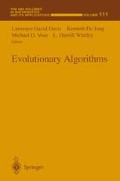Abstract
This paper describes a hierarchical genetic algorithm (GA) framework for identifying closed form functions for multi-variate data sets. The hierarchy begins with an upper GA that searches for appropriate functional forms given a user defined set of primitives and the candidate independent variables. Each functional form is encoded as a tree structure, where variables, coefficients and functional primitives are linked. The functional forms are sent to the second part of the hierarchy, the lower GA, that optimizes the coefficients of the function according to the data set and the chosen error metric. To avoid undue complication of the functional form identified by the upper GA, a penalty function is used in the calculation of fitness. Because of the computational effort required for this sequential optimization of each candidate function, the system has been implemented on a Cray supercomputer. The GA code was vectorized for parallel processing of 128 array elements, which greatly speeded the calculation of fitness. The system is demonstrated on five data sets from the literature. It is shown that this hierarchical GA framework identifies functions which fit the data extremely well, are reasonable in functional form, and interpolate and extrapolate well.
Access this chapter
Tax calculation will be finalised at checkout
Purchases are for personal use only
Preview
Unable to display preview. Download preview PDF.
References
Angeline, Peter J., Two self-adaptive crossover operators for genetic programming, Advances in Genetic Programming Volume II (editors: Peter J. Angeline and Kenneth E. Kinnear, Jr.), MIT Press, Cambridge MA, 89–109, 1996.
Bäck, T. and Schwefel, H. P., An overview of evolutionary algorithms for parameter optimization, Evolutionary Computation, 1, 1–23, 1993.
Bastian, A. and Gasos, J., A type I structure identification approach using feed forward neural networks, IEEE International Conference on Neural Networks, 5 (of 7), 3256–3260, 1994.
Bleasdale, J. K. A. and Nelder, J. A., Plant population and crop yield, Nature, 188, 342, 1960.
Box, G. E. and Jenkins, G. M., Time Series Analysis: Forecasting and Control, Holden-Day, San Francisco, CA, 1970.
Coin, D. W. and Turner-Jackson, B. and Smith, A. E., Static neural network process models: considerations and case studies,International Journal of Production Research, 36 in print, 1998.
Collins, J. S., A regression analysis program incorporating heuristic term selection, Machine Intelligence, Donald Michi, Editor, American Elsevier Company, New York NY, 1968.
Cramer, N. L., A representation for the adaptive generation of simple sequential programs, Proceedings of an International Conference on Genetic Algorithms and Their Applications, 183–187, 1985.
Dallemand, J. E., Steepwise regression program on the IBM 70, Technical Report of General Motors Research Laboratories, 1958.
Farazdaghi, H. and Harris, P. M., Plant competition and crop yield, Nature, 271, 289–290, 1968.
Friedman, J., Multivariate adaptive regression splines, Department of Statistics Technical Report 102, Stanford University, 1988 (revised 1990).
Fujko, C. and Dickinson, J., Using the genetic algorithm to generate LISP source code to solve prisoner’s dilemma, Genetic Algorithm and Their Applications: Proceedings of the Second International Conference on Genetic Algorithms, 236–240, 1987.
Gallant, A. R., Nonlinear Statistical Models, John Wiley and Sons, New York, 1987.
Geman S. and Bienenstock, E., Neural networks and the bias/variance dilemma, Computation, 4, 1–58, 1992.
Gulsen, M., Smith, A. E. and Tate, D. M., Genetic algorithm approach to curve fitting, International Journal of Production Research, 33, 1911–1923, 1995.
Holliday, R., Plant population and crop yield, Field Crop Abstracts, 13, 159–167, 247–254, 1960.
Karr, C. L., Stanley D. A., and Scheiner B. J., Genetic algorithm applied to least squares curve fitting, U.S. Bureau of Mines Report of Investigations 9339, 1991.
Koza, J. R., Genetic Programming: On the Programming of Computers by Means of Natural Selection, MIT Press, Cambridge MA, 162–169, 1992.
Koza, J. R., Genetic Programming: Automatic Discovery of Reusable Programs, MIT Press, Cambridge MA, 1994.
Mühlenbein, H. and Schlierkamp-Voosen, D., Predictive models for the breeder genetic algorithm. I. Continuous parameter optimization, Evolutionary Computation, 1, 25–49, 1993.
Nash, J. C. and Walker-Smith, M., Nonlinear Parameter Estimation: An Integrated System in BASIC, Marcel Dekker, New York, 1987.
Park, Y. R., Murray, T. J. and Chen, C., Predicting sun spots using a layered perceptron neural network, IEEE Transactions on Neural Networks, 7 501505, 1996.
Rogers, D., G/Splines: A hybrid of Friedman’s multivariate adaptive regression splines (MARS) algorithms with Holland’s genetic algorithm, Proceedings of the Fourth International Conference on Genetic Algorithms, 384–391, 1991.
Seber, G. A. F. and Wild, C. J., Nonlinear Regression, John Wiley and Sons, New York, 1989.
Stiglek, S. M., History of Statistics: The Measurement of Uncertainty Before 1900, Harvard University Press, Cambridge MA, 1986.
Sugeno, M., and Yasukawa, T., A fuzzy-logic-based approach to qualitative modeling, IEEE Transactions on Fuzzy Systems, 1, 7–31, 1993.
Villareal, J. and Baffes, P., Sunspot prediction using neural networks, University of Alabama Neural Network Workshop Report, 1990.
Westervelt, F., Automatic System Simulation Programming, unpublished Ph.D. Dissertation, University of Michigan, 1960.
Author information
Authors and Affiliations
Editor information
Editors and Affiliations
Rights and permissions
Copyright information
© 1999 Springer Science+Business Media New York
About this chapter
Cite this chapter
Gulsen, M., Smith, A.E. (1999). A Hierarchical Genetic Algorithm for System Identification and Curve Fitting with a Supercomputer Implementation. In: Davis, L.D., De Jong, K., Vose, M.D., Whitley, L.D. (eds) Evolutionary Algorithms. The IMA Volumes in Mathematics and its Applications, vol 111. Springer, New York, NY. https://doi.org/10.1007/978-1-4612-1542-4_6
Download citation
DOI: https://doi.org/10.1007/978-1-4612-1542-4_6
Publisher Name: Springer, New York, NY
Print ISBN: 978-1-4612-7185-7
Online ISBN: 978-1-4612-1542-4
eBook Packages: Springer Book Archive

